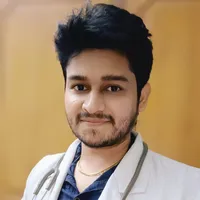Bhramari Pranayama Steps, Benefits, and How It Helps Mind Calm
Discover bhramari pranayama benefits and how to do the humming breath safely. Simple steps to ease stress, improve focus, and support better sleep

Written by Dr. M L Ezhilarasan
Reviewed by Dr. Shaik Abdul Kalam MD (Physician)
Last updated on 15th Nov, 2025

Introduction
When your mind feels busy, tense, or overwhelmed, even small acts of stillness can make a big difference. Bhramari pranayama—often called the humming breath—is a gentle breathing technique that uses a soft hum during the exhale to calm the nervous system. It is simple enough for beginners, requires no equipment, and can be practised almost anywhere: at your work desk, before sleep, or whenever you need to settle your thoughts. Many people use it to reduce day-to-day stress, clear mental fog before work or study, or unwind in the evening. This guide explains how to learn bhramari step by step, what the benefits may include, and how to use it safely and consistently to support emotional balance and mental clarity.
What Is Bhramari Pranayama (Humming Breath)?
• Bhramari comes from the Sanskrit word for “bee,” inspired by the humming sound made during the exhale.
• Unlike complicated breath-control practices, bhramari is accessible to both beginners and experienced practitioners.
• You inhale gently through the nose, then exhale slowly with a relaxed humming sound that vibrates through your throat, face, and head.
Many people describe the vibration as soothing and grounding. The sound naturally draws your attention inward, helping to quiet racing thoughts and create a comforting inner stillness.
Consult a Top General Practitioner for Personalised Advice
How Bhramari Calms the Mind and Nervous System
Slow, controlled breathing is known to help activate the parasympathetic nervous system—the part responsible for rest, recovery, and digestion. Bhramari helps achieve this because:
• The prolonged, gentle exhale encourages the body’s relaxation response.
• The steady hum gives your attention a single point of focus, reducing mental noise.
• Nasal breathing promotes a slower heart rate and supports a sense of calm.
Even though large clinical studies specifically on bhramari pranayama are limited, the science behind slow breathing and relaxation is well established. Bhramari offers an easy, sensory way to apply these principles.
Bhramari Pranayama Benefits: What Research and Experience Suggest
Potential benefits include:
• Eases day-to-day stress
Slow breathing helps regulate the body’s stress response, reducing tension in the mind and body.
• Supports focus and mental clarity
The vibration and sound create a simple internal “anchor,” which can help reduce distractions.
• Helps prepare for sleep
Bhramari encourages a slower breathing pace, making it a useful bedtime ritual to promote winding down.
• May support heart rate and blood pressure in the moment
A slow and lengthened exhale can encourage a calmer physiological state.
• Complements stress and anxiety management
Bhramari can be part of a wider self-care plan to help manage stress, though it should not replace professional care.
The effect of bhramari is immediate enough that even one round can bring a noticeable shift in how present and grounded you feel.
Step-by-Step Guide: How to Practise the Humming Breath (Bhramari)
The step by step guide includes:
1) Find a comfortable position
• Sit on a chair or cushion with an upright but relaxed posture.
• Keep your shoulders soft, jaw relaxed, and lips gently closed.
• Teeth should be slightly apart — this helps the vibration flow smoothly.
2) Settle into your breathing
• Inhale gently through your nose for about three to four seconds.
• Exhale naturally through your nose to settle the breath before adding sound.
3) Add the humming sound
• Inhale softly through the nose.
• As you exhale, make a gentle “mmm” sound, like a relaxed hum.
• Aim for an exhale of six to eight seconds, but only if comfortable.
4) Notice the vibration
• Pay attention to how the vibration feels around the nose, lips, and face.
• If your mind wanders — which is normal — guide it back to the sensation of the sound.
5) Repeat for three to five minutes
• Try 5–8 rounds to begin with.
• Over time, build to 5–10 minutes once or twice daily.
Optional hand variation for deeper sound isolation
• Lightly press the cartilage flaps over your ears using your index fingers (do not insert anything into your ear canal).
• Keep elbows relaxed and avoid pressing too hard.
This version enhances internal sound, making it easier to focus, but it is completely optional.
Helpful pacing reminders
• Try breathing in for 4 counts and humming out for 6–8 counts.
• Comfort matters more than length. Never force the breath.
Practical Ways to Use Bhramari in Daily Life
The practical ways to use bhramari include:
• Morning focus routine
A calming start before checking messages or scrolling your phone.
• Work break reset
Two to three rounds between calls or meetings to reduce tension.
• Pre-study or pre-exam clarity
Helps clear distractions and improves concentration.
• Evening wind-down
Gentle humming signals the body to shift towards rest.
• During emotional overwhelm
Even two slow, humming breaths can interrupt spiralling thoughts or panic.
Common Mistakes to Avoid
• Forcing the sound
The hum should be soft, not loud or strained.
• Holding tension
Relax your jaw and throat — this enhances vibration.
• Straining to lengthen the breath
If the exhale feels uncomfortable, shorten it.
• Pressing the ears too strongly
Gentle pressure only. If you have ear discomfort, avoid this variation.
• Slouching
A long, relaxed spine allows smoother airflow and deeper calm.
Is Bhramari Right for You? Safety and When to Seek Advice
Bhramari is gentle and safe for most people, but consider the following:
• If you experience dizziness, light-headedness, or discomfort, pause and return to natural breathing.
• If you have an active ear infection or ear sensitivity, avoid closing the ears and practise without hand placement.
• If you are pregnant, have respiratory or cardiovascular concerns, or are unsure whether breathwork is appropriate, speak to a healthcare professional.
Breathwork should always be supportive, not stressful.
How Often Should You Practise?
The frequency of practice:
• Beginners: 5–8 rounds, once a day (about 3–5 minutes).
• Building consistency: 5–10 minutes, once or twice a day.
• When under pressure: Use shorter, more frequent sessions—such as two rounds between tasks.
The key to lasting benefits is regular practice, not long sessions.
Why Bhramari Is Great for Beginners
• It is simple—there is no complex counting or pattern to remember.
• The hum acts as a natural anchor for concentration.
• It offers immediate feedback, helping the mind stay in the present moment.
• It can be done discreetly, even in busy environments.
The more approachable a practice is, the more likely you are to make it part of your routine.
Bhramari Pranayama vs Other Breathing Techniques
Other breathing techniques, such as diaphragmatic breathing, box breathing, and paced breathing, all offer benefits for calming the nervous system. Bhramari differs because:
• The humming sound creates a clear point of focus.
• The vibration encourages lengthening of the exhale.
• It can feel playful and intuitive, which helps beginners stick with it.
Instead of fighting wandering thoughts, bhramari gives the mind something gentle to focus on.
Tracking Your Progress
• Rate your stress before and after practising (1–10 scale).
• Notice physical changes: slower breathing, softer shoulders, calmer heart rate.
• Use cues or reminders to stay consistent: before emails, before bed, or after work.
• Even 60–90 seconds can shift your state if practised mindfully.
Conclusion
Bhramari pranayama offers a quiet, steady way to return to yourself. By extending the exhale and giving the mind a soft point of focus, bhramari helps interrupt stress patterns and encourages calm clarity. The technique requires no equipment, no special setting, and only a few minutes—making it easy to integrate into everyday life. While bhramari does not replace professional care for health conditions, it can be a supportive habit to help manage stress, improve focus, and ease the transition into sleep. Consistency matters more than perfection. Whether you hum for one minute or ten, each breath is a reminder that calm is always accessible.Consult a Top General Practitioner for Personalised Advice
Consult a Top General Practitioner for Personalised Advice

Dr. Suvadeep Sen
Critical Care Specialist
12 Years • MBBS, MD, FNB (CRITICAL CARE MEDICINE), EDIC
Mumbai
Apollo Hospitals CBD Belapur, Mumbai

Dr. Tanmaya Kumar Sahu
General Physician/ Internal Medicine Specialist
12 Years • MBBS, MD ( Internal Medicine )
Bhubaneswar
Apollo Hospitals Old Sainik School Road, Bhubaneswar

Dr Suseela
General Physician
5 Years • MBBS
Bengaluru
Apollo Medical Center, Marathahalli, Bengaluru

Dr. Mainak Baksi
General Practitioner
13 Years • MBBS , MD (MPH)
Howrah
Mainak Baksi Clinic, Howrah
(50+ Patients)

Dr. Rajib Ghose
General Physician/ Internal Medicine Specialist
25 Years • MBBS
East Midnapore
VIVEKANANDA SEBA SADAN, East Midnapore
Consult a Top General Practitioner for Personalised Advice

Dr. Suvadeep Sen
Critical Care Specialist
12 Years • MBBS, MD, FNB (CRITICAL CARE MEDICINE), EDIC
Mumbai
Apollo Hospitals CBD Belapur, Mumbai

Dr. Tanmaya Kumar Sahu
General Physician/ Internal Medicine Specialist
12 Years • MBBS, MD ( Internal Medicine )
Bhubaneswar
Apollo Hospitals Old Sainik School Road, Bhubaneswar

Dr Suseela
General Physician
5 Years • MBBS
Bengaluru
Apollo Medical Center, Marathahalli, Bengaluru

Dr. Mainak Baksi
General Practitioner
13 Years • MBBS , MD (MPH)
Howrah
Mainak Baksi Clinic, Howrah
(50+ Patients)

Dr. Rajib Ghose
General Physician/ Internal Medicine Specialist
25 Years • MBBS
East Midnapore
VIVEKANANDA SEBA SADAN, East Midnapore
More articles from General Medical Consultation
Frequently Asked Questions
Q.What are the main bhramari pranayama benefits?
Commonly reported benefits include easing stress, improving focus, supporting sleep, and encouraging a calmer heart rate. These align with what is known about slow, controlled breathing techniques that activate the body’s relaxation response.
Q.How long should I practise to feel calmer?
A.You may notice a shift in one to three minutes. For a deeper effect, practise for five to ten minutes. If you feel lightheaded, stop and breathe normally.
Q.Can children or older adults practise bhramari?
A.Yes. It is gentle and can be made playful for children by pretending to “buzz like a bee.” For older adults, use a comfortable chair and keep breathing soft and unforced.
Q.Is bhramari safe if I have asthma or anxiety?
A.For many people with mild asthma or anxiety, gentle nasal breathing can feel soothing. If symptoms are more severe or unpredictable, consult a clinician first.
Q.When is the best time of day to practise?
A.Anytime you need calm. Morning, mid-day resets, and evenings before bed are popular. Consistency helps — pair it with something you already do, such as brushing your teeth or logging into your computer.




